Introduction
Let’s get this out of the way first: The vintage versions are technically not called mini-humbuckers, mini-hums, mini-HB1s, or probably anything else you may have heard or read unless you’ve read Hans’ book in which they are properly called Anti-Hum pickups. I will often eliminate the hyphen and refer to them as AntiHum pickups.While Anti-Hum is the proper name for the vintage pickups made in the 1960s, (and perhaps the early ’70s but we’ll get to that in a minute), if they were made in the 2010s they are properly called Little Buckers or LB1s, a name that I personally find adorable.
Let’s take a look at each and then see how they compare.
Anti-Hums – 1960s
From what I’ve been able to gather, Guild sold the original Anti-Hum pickups from about 1963 to 1969 with some showing up in 1970. In 1970 Guild transitioned to the larger HB1 humbuckers but I’ve seen a couple of 1970 Guilds with Anti-Hum pickups on various Internet sites. Guild is notorious for serial numbers kind of blurring the lines between years so just because the guitar has a 1970 serial number doesn’t mean that the pickups found in it weren’t made in an earlier year.Sadly, Anti-Hum pickups have no date stamps or codes on them that I’ve ever seen, though some appear to have the remnants of something having been ink-stamped or written on them, though I should point out that it is entirely possible that this was done years later when people removed them from guitars. Most of any trace of such a stamping has long since worn away, though, except where people have written or taped identifying marks on them. Remember that these pickups are sometimes over 50 years old and may have been owned by many people.
To try and learn more about these pickups I spent far too much time and tracked down a pile of online auctions, internet message board posts, and anything else I could find (including my own measurements) and put together a spreadsheet of almost 70 AntiHum pickups, an image of which is shown to the right. Over time as I add new pickups I will update this data so that it stays current. [List was Last updated March 9th, 2019]From the information I have, there seems to be two major variations of these pickups. The first, which I’ll call the 7k series, can be found in guitars from about 1963 to about 1968 and have a DC resistance in the roughly 6.5k-7.9k range. The second, which I’ll call the 5k series, seems to show up in guitars in 1969 and 1970 and had a much lower resistance in the roughly 5.1k-6k range.
If you have a 1960s or early 1970s Guild with Anti-Hum pickups and you’d like to contribute data for the cause, please leave a comment with the DC resistance of both pickups along with the year and type of your guitar. If you don’t know how, leave a comment or send me an email and I’ll help you out. Thanks!
From the information that I’ve gathered, these pickups were always issued in matched pairs with each pickup being of the same major variation and with the bridge pickup either matching or reading slightly hotter than the neck pickup. Trying to see if they were installed in matched pairs is actually why I started collecting the data, the results of which will become important later on when I talk about the new LB1 pickups.
Pickups from the 5K years appear to have the word Guild stamped on the base plate, though to be fair the only one of these I’ve seen in the wild is shown here which is from this Reverb auction. If true, this is an important further physical differentiator between the earlier 7k series and the later 5k series, though I must again point out that my observations are from a pretty limited data set as these pickups don’t show up for sale very often.These pickups were made by or for Guild in the United States.
Bridge
The pickup shown here is an Anti-Hum from a 1964 Starfire III. It appears as though the bridge pickups usually has a hole in it based on the observations of many of us on the LetsTalkGuild forum. This is hard to prove because I’ve seen sets sold where both had the holes, but remember that over the years pickups may have been mixed and matched so that pairs being sold today may very well have not been paired originally. The only way to tell for sure would be to properly measure the pole-spacing on a sampling of pickups with and without the hole. Since the bridge pickup has slightly wider spaced pole pieces, this might add credence to the idea of the hole marking the bridge base plate because it would help to differentiate the bridge pickup base from the neck pickup base during assembly. On my example here, you may notice that the pole pieces are of two different heights as viewed from the back. They are all at the same level on the front of the pickup, so it would appear that these are different length poles. From the pictures I’ve seen including the other pickup in this set, this seems to be an anomaly. For reference, the picture from the beginning of this article, which is again shown here, is the front of this very same pickup.Neck
The pickup shown here is the matching Anti-Hum from a 1964 Starfire III. With the exception of the missing hole, this pickup looks just like the bridge pickup. As stated earlier, the neck pickup usually measure the same or slightly less DC resistance than the bridge pickup in the same guitar. This pickup has the same length pole pieces as do most of the examples I’ve seen. Not the absence of the hole on in the baseplate. The pole pieces measure slightly closer together than the ones on the bridge pickup. This measurement will be shown in the AntiHum and LB1 Differences section.I’ve noticed on the vintage Anti-Hum pickups that the covers are soldered on at the four corners and not in the middle like most humbuckers. I find this interesting because it would be more labor intensive to do it this way.
Minor Variations
A very observant LetsTalkGuld user has noticed that there are some variations in the vintage Anti-Hums. This set, which has been attributed to Ken Nash over at TheGuitarMechanic.com shows a second row of holes on the bottom pickup which appear to have the bottom of slugs or screws showing in them. This is an interesting development because the only time I’ve seen these pickups without covers showed that the secondary coil actually didn’t contain slugs, but rather what appeared to be a bar magnet or more likely a large bar slug. Note that both of these pickups have the center hole so it’s possible (though not certain) that these were actually both bridge pickups. The same user found this pictured sample from the GuitarJoe.at site. This pickup seems to use the same baseplate as the one above, but on this sample there appears to be no slugs or screws showing in the second row of holes. At this time I have no information as to the DC resistance of these pickups, all of which appear to be bridge pickups based on the central hole theory. Note that these two variations may in fact be the same. Without seeing and measuring these pickups in person I can’t say for sure what’s going on.Newark St. Reissues – 2013-Current
In 2013 Guild released a new line of guitars called the Newark St. Collection. These guitars are all made in Korea (the Jetstar appears to be made in China) and are more or less modern versions of famous Guild models from the 1960s and ’70s. In order to make these guitars great, Guild (then owned by Fender) tried to recreate the magic of the original Anti-Hum pickups by buying a set on the Internet to have them analyzed and recreated. Unfortunately, they made a mistake and seemed to have purchased a neck pickup from the 7k series and a bridge pickup from the 5k series. It’s entirely possible that they bought a single set as I’ve found them being sold together. Hell, given the date of the auction, it’s possible they even bought this very set.2020 Edit: I found this video from 2013 NAMM where Mike Lewis from Fender comments that they bought a set to have duplicated without any mention of the fact that the bridge pickup is much weaker than the neck, though you can hear it when he demos the guitars.
This appears to be why the bridge pickup on all Newark Street Guild guitars sounds so weak and thin: it’s a 5k pickup. It’s not that it’s a bad pickup, but it is terribly matched with the more powerful 7k neck LB1. This is very unfortunate because aside from this mistake, the pickups are pretty darn great.
Sadly, it would appear that no one thought to question the fact that the single set they used as a sample was so horribly mismatched. I have to assume it was a single set because had they analyzed any other sets they would have noticed the discrepancy. I know for a fact that Guild had access to actual vintage guitars from the ’60s, so why they didn’t measure those is anyone’s guess. During the midst of people discovering the problem, Fender (which I have from reliable sources was well aware of the problem) sold Guild to Cordoba Music Group (CMG) in 2014.Instead of admitting the problem and fixing it, Guild (now owned by CMG) released this statement in 2015 which explains that guitar pickups should not just be judged on their DC resistance (true) and that the 5k bridge pickup is only 5k because they used thicker wire which means that it has fewer winds (which may also be true). They then go on to say that we shouldn’t judge on specs alone (true) and that we should use our ears (very true). Unfortunately, it is by using our ears that many of us discovered that there was a problem in the first place.
If you don’t believe me, just watch this video from Reverb’s report of NAMM 2018 where Guild shows off the new Jetstar guitar. At the 1:00 mark, the Jetstar is demoed and the player starts with a killer-sounding riff on the neck pickup which sounds amazing. He then switches to the bridge pickup which sounds thin and anemic after which he quickly switches back to the neck pickup because it sounds so much better.
I should point out that this mess started when Fender owned Guild but unfortunately the problem persists under the new ownership. These pickups have been a problem since they were first released in 2013 and the new guitars in 2018 still have the problem. Hey Guild – fix this! You have done a great thing by rereleasing these pickups, but your nice Newark St. guitars are crippled in their current configuration with these mismatched pickups.
How to Rectify
In an effort to better balance the volume in guitars with LB1s, I’ve had some luck by lowering the neck pickup and raising the bridge pickup, but that pulls the neck pickup too far from the stings and robs it of the magic you can get when its in its sweet spot. It also makes the entire guitar sound weaker than it should, at least to my ears.There are two ways to rectify the problem using current parts as replacements. Either put another bridge pickup into the neck position or put another neck pickup into the bridge position (my preference). In other words, match the pickups the way Guild should have in the first place. Putting a neck pickup in the bridge will mean your guitar will have two ~7k pickups, just like the min-’60s vintage models. If you prefer the lower-output of a ~5k pair (like the ’69 M75s), then use two bridge pickups.
The downside to putting a neck pickup into the bridge position of a guitar (or vice versa) is that the pole pieces won’t line up with the strings on both pickups because bridge pickups have wider spaced pole pieces than neck pickups. Honestly, whatever shortcoming this may have (my guess being none aside from cosmetic) are more than offset by the delicious lead tones that you’ll now get by having matched and balanced pickups in your guitar.
Finally, there is another option that’s a little more involved. You can have the pickups rewound. In order to do this you’ll need to pull them from your guitar (or order new ones) and ship them to a rewinder. Radioshop Pickups in the UK will rewind your Guild LB1 pickups so that they have a proper balanced output. There’s even a cool video to show how they do it here which has the added benefit of showing that the LB1s appear to be wax potted.
Bridge
The LB1 bridge pickups is available as a part from Guild at this link (nickel) on the guildguitars.com website. It is listed as having an Alnico 5 magnet and a DC resistance of 5.06k. It comes with the ring and mounting screws for the (2018) price of $80 US. As of February 2018, Guild lists the gold version of this pickup as having a DC resistance of 7.20k. I bought one of these to test and can confirm that it has a DC resistance of 5.05k and not 7.20k as advertised.The bridge pickup has a solder terminal on it like the old ones, but there is also a blue lead soldered and insulated which terminates in a quick-disconnect of the type used in Newark St. guitars. The attached lead wire on the gold one I have is black. If you’re going to use this in a vintage guitar you can simple desolder the lead and use the solder terminals.
The pickup is stamped GUILD R with the R standing for rear pickup which is a term sometimes used for the bridge position. From the factory these pickups have RoHS compliancy sticker and a BRIDGE PICK UPS BHK sticker with BHK being the abbreviation for BooHeung Precision Machinery in Korea where the pickup is made.Note that unlike the vintage Anti-Hums, these pickups have their covers soldered in the middle and not at the corners.
Neck
The LB1 neck pickup is available as a part from Guild at this link (nickel) on the guildguitars.com website. It is listed as having an Alnico 5 magnet and a DC resistance of 7.20k. The gold version of this pickup also has a listed DC resistance of 7.20k (mine measured 7.41k). It comes with the ring and mounting screws for the (2018) price of $80 US. The gold model is essentially identical with the obvious difference being the gold cover.This pickup also has the solder terminal with attached lead, with the lead on both of my examples having black covers while the one on the website shows a red cover.
The pickup is stamped GUILD F with the F standing for front pickup which is a term sometimes used for the neck position. From the factory these pickups have RoHS compliancy sticker and a BRIDGE PICK UPS BHK sticker with BHK being the abbreviation for BooHeung Precision Machinery in Korea where the pickup is made.
Like the bridge version, these pickups have their covers soldered in the middle and not at the corners.
Anti-Hum and LB1 Differences
Given a guitar with this style of pickup in it, how can you tell which pickup is installed without pulling it and examining the back? In other words, is there a way to tell if a seller is trying to sell you a modern Korean LB1 in that vintage Starfire?The first thing that’s only obvious if you put a vintage AntiHum and a modern LB1 side by side is the finish. The Guild LB1 pickups are finished in nickel while the older Anti-Hum pickups are finished in chrome. As you can see in this picture, the LB1 on the left clearly has a deeper color to it. Nickel is often described as being yellower than chrome and chrome is often described as being bluer than nickel, so that’s one way to remember the difference. Remember, the pickup on the right is from 1964 so it’s over fifty years old and still looks shiny. While chrome may pit over time, it will not yellow like the pickup on the left. If you’re looking at a vintage Guild and one of the pickups has a deeper color to it like the one on the left, it’s probably a replacement.
I should point out that I have not compared vintage gold AntiHums with modern gold LB1s, but given the thin plating of gold present on vintage pickups, chances are that if the pickup is bright, shiny, and looks new, then there’s a good chance that it is because vintage gold pickups from Guild look worn after very little use.
The vintage Anti-Hums and modern LB1s are practically identical in size. Note that the bridge pickup of both models has wider pole pieces than the neck pickup does, though you can’t really see that without measuring as the difference is slight. With the exception of the plating (chome vs. nickel), the two pickups are practically indistinguishable from the front. The rings, however, have some clues as to their origin.
The measurements of the vintage vs. modern rings is very similar with the short side being 1 11/16″ on the vintage rings and 1 5/8″ on the LB1 rings. The width of the side piece is another slight change but that is not severe. The main difference when looking at them in-hand is the corners and the ring heights.
I must point out that the vintage rings in my possession seem to be only one type of vintage ring and there appear to be some variations. This 1968 Guild M75 shows rings that more closely resemble the modern LB1 rings in that they have very curved corners, thought the bridge pickup ring does not appear to be tilted like the modern one as seen in the next image. This picture also shows a good example of what vintage gold AntiHums look like with much of the gold plating having worn away over the years. Shown to the right are the rings from a modern LB1 bridge pickup on the left and a vintage Anti-hum bridge pickup on the right. As you can see they are quite different with the new ring adding a fair bit of tilt to the pickup. The tilt in the bridge ring is a nice addition because these pickups do not tilt easily like the later HB1 pickups that have three adjustment screws. Indeed, I had problems on my Newark Street S200 T-Bird where I had to bend the pickup ears to make it sit parallel with the strings. The tilted rings would have solved that problem but that’s a moot point because the S200 doesn’t use rings since it has pickguard-mounted pickups. The neck pickup rings are similar in vertical height while having the same characteristics of their respective eras such as the angled vs. curved corners. Looking further at the “will they fit” angle, I should point out that the screw holes all line up perfectly as shown by me putting four mounting screws through all four holes through both pickup ringss at once. This is a good thing if you’re looking to either put vintage rings on a Newark St. guitar or if you want to replace a broken vintage Anti-Hum pickup with a new LB1. Or, you know, you just want to replace the pickup ring. The rings from both eras seem to be of quality construction with no complaints from me in that regard. This picture shows new LB1 on the left and the vintage AntiHum on the right. Notice that the ring of the newer pickup (left) has more rounded corners while the vintage ring (right) is very squared. Here you can also see the slight difference of length on the rings’ short side in that the vintage ring appears to be “taller” in this picture. Finally, this picture shows another example of the difference in the nickel finish of the LB1 and the chrome finish of the vintage AntiHum. The ring differences are even more pronounced in the next picture. Another cosmetic difference is the adjustment screws. On the modern LB1 pickup (left) the adjustment screw is small and has a Phillips head. On the vintage Guild AntiHum (right) the adjustment screw is larger and has a slotted head. These larger slotted head screws are a good sign of vintage pickups unless someone replaced the pickup and kept the adjustment screw (and yes, I’ve seen that), in which case the color and tone of the plating should help you to identify the pickup if you can’t remove it from the guitar. It’s also possible that someone could have replaced the screw so this is not a perfect test, but it can help when trying to identify what pickups are in a vintage guitar.Oddly enough, it looks to me like the adjustment screw on the vintage Anti-Hum looks like nickel while the one on the modern LB1 looks chrome. I point this out because they are the opposite of the pickup covers so don’t expect to see a nickel-colored adjustment screw just because you have a nickel-plated pickup cover.
Conclusion
Can you use modern Little Bucker LB1 pickups to replace vintage Guild AntiHums? Well, yes and no. They fit and look similar, but the plating is different and the windings are not really right on the bridge pickup. You can use a neck pickup in the bridge position but the pole pieces won’t line up under the strings properly, though that probably won’t matter to the sound. The bigger deal is the fact that the finish is different and the two pickups won’t match unless you replace them both.Really, though, you’ll need to check the DC resistance of the original pickups. If you have a 1969 Anti-Hum with a ~5K DC resistance, your only choice is the LB1 bridge pickup. If you have an earlier model with a ~7K DC resistance, then the LB1 neck pickup is a better bet, even though the pole pieces may not line up depending on where you install it. .
If you do put modern LB1s in a vintage Guild, do the right thing and put that fact in the ad if you sell the guitar. I’ve found more than one vintage Guild with modern LB1s in it and sometimes the seller didn’t even know they were there having been sold a vintage instrument with modern replacement parts in the past The guitar in this picture is such an example where the bridge pickup in this 1960s Starfire had been replaced with a modern LB1 which is obvious when you notice that one is nickel (bridge) and one is chrome (neck).Hopefully this information helps everyone to be a more informed buyer of those sweet vintage Guild pickups that we all adore.
Donate: PayPal Crypto:

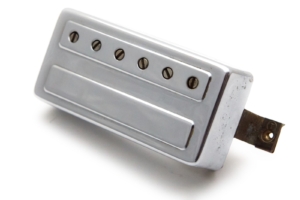
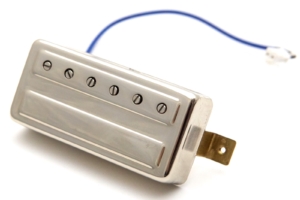
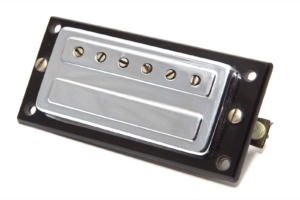
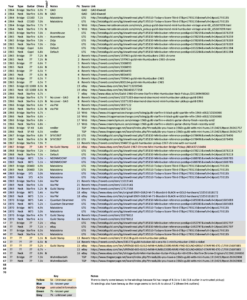
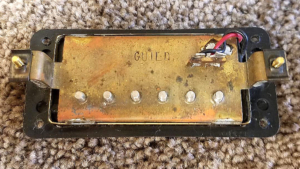
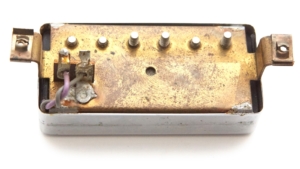
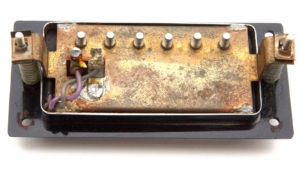
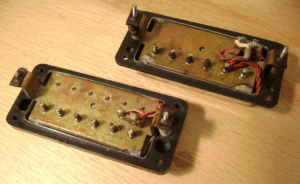
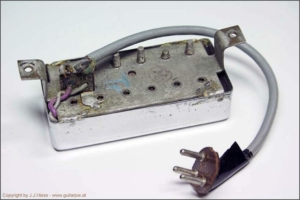
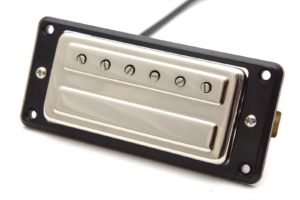
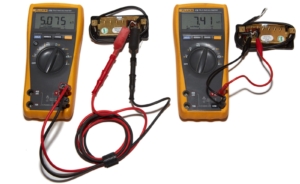
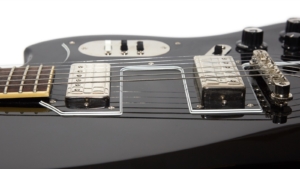
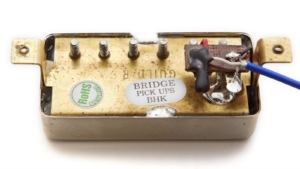
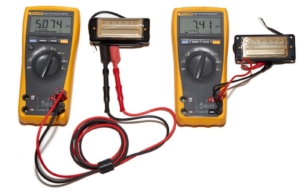
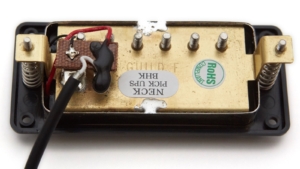
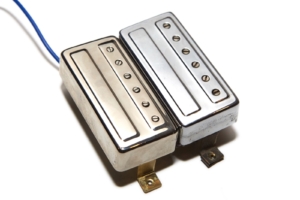


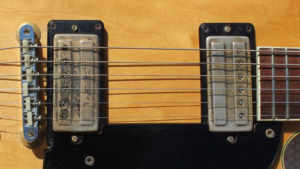
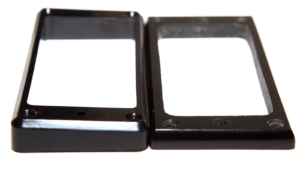
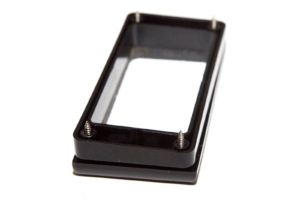
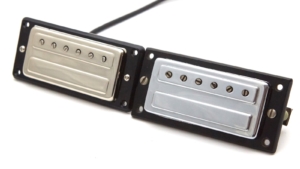
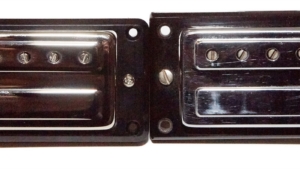
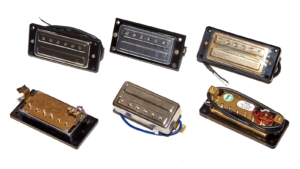
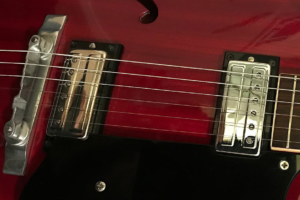
A brilliant read as usual, Gary.
Please give me a Twitter follow.
Patrick.
thank you. can we substitute these without alteration into a guitar that takes regular sized (e.g. Gibson 490R and 490T) humbucking pickups?
also, I have an old (early 70s) Guild S100 with wonderful sounding pickups. they don’t look to be the exact same size as Gibson’s either. are those the same size and sound as these LB1s?
The Anti-Hum and LB1 pickups are “minihums”, so they are smaller than “regular” humbuckers like the Gibson 490R, etc.
An early ’70s Guild S100 would have HB1 pickups in it. You can read about them at this link.
I have a 1963 S-50 Jetstar Ser# 26501. It’s a single pickup model which doesn’t look like any of the pics I’ve seen posted. The size seems consistent with the anti-hum and LB-1 but the screws are down the center, not offset like the bridge and neck units. Any ideas? I’m looking to replace it>
I’m not sure what they’re called, but they’re shown on page 32 of Hans’ book “The Guild Guitar Book”. I have not examined one of these in person and therefore cannot tell you much about them.
Thanks for the reply GAD.
Do you know if there are any original style or aftermarket replacements for these?
Sorry – I’ve never done any research on them. You might contact Hans through his website at https://www.guitarchives.nl
Sounds like you might have an older model with the D’Armond PUs – 63 was the last year for those I think. Seymour Duncan makes a replica model of those.
I thought I’d share some intriguing details about a 1966 Starfire III with mini-hums that I’ve owned since the late 1970s. While doing a bit of maintenance, I pulled the PUs out and have the following info to offer:
1 – Neck PU ~ 4.9k (this was repaired. The PU lost a few windings in the process so was probably closer to 5k originally).
2 – Bridge PU = 7.04 k (unmodified).
3 – Pickup Ring Corners (original) were rounded.
4 – Other identifying details (pole spacing, baseplate etc…) match what you have for the vintage versions.
Just offhand. it seems possible that they might have used a guitar from this production run to design the modern version PUs.
BTW – I switched the PU positions years ago. Big improvement. A guy sold it to me cheap because the bridge pos sounded tinny and the neck sounded muddy – no more!
Just a shoutout here to Radioshop Pickups in Wales, the rewind shop that Gary mentions. I just got back from them the bridge LB-1 from my Newark St. Starfire III, and it’s a world of difference. See the video on their site. They know the fix for those bridge pickups. Around $100 + shipping to the UK… an easy transaction with a communicative shop. Highly recommended. Those Newark Street guitars are really quite nice. But as Gary describes, they require some kind of fix for the pickup issue.
Hey Gary,
6.8k neck
6.58 bridge
1965 CE100D Capri
I’ve a 64 starfire ii with the rows of holes in both sides of the back plate of the bridge pickup. Measures 6.8. Very sadly I don’t have the neck pickup and am trying to source one for reasonable money! Email me if you’d like a picture and serial number etc.
Mike
Hi- I have one of the silver base plate mini hums from the 60s. It measures about 7k.
I had a pair of them and several guitars with the brass coloured plates to compare. They sound stronger.
Hi and thanks to a great article!
I have a Guild Starfire IV from 1965 which was at that time my father bought new. The guitar is still totally original.
Neck pickup: 7.06 Kohm
Bridge pickup: 7.15 Kohm
I have a question, are these vintage pickups wax potted or unpotted?
Greetings from Sweden
Lars
Hey there! Those pickups are the vintage AntiHums. They are beyond wax potted – they are fully encased in epoxy! Here’s a teardown of one: https://www.gad.net/Blog/2018/03/13/guild-antihum-mini-humbucker-pickup-teardown/
Yea, very nice article, I found it and read it with great interest.
Do you know if the epoxy have effect on the tone?
I am really happy I found your blog, I have been living with this guitar all my life, hell I would’nt even been born maybe if father had’nt been out gigging with it in the sixties and in those circumstances met my mother. =))
Hi, thanx very much for the detailed article. Very interesting.
I was offered one of the recent Starfire IV St Maple (the emerald green one). Great guitar but I don’t like the pickups, the LB-1s. I would like to put P90s instead. Is it possible without altering the body? And If so, do I also need to change the pots?
Thank you for your reply,
Nicolas
If memory serves, P90s don’t quite fit right, but I have not tried myself. As for the pots, that’s up to you. I’ve seen all manner of pot configurations with P90s.
Thanks for this! Do you think that any other Mini-Humucker would fit in the Bridge? For example a Gibson Firebird Mini Humbucker?
Sorry – I have no idea.
Hi Gary.
My November 2015 Newark Street Starfire III LB-1 pickups measure 7.39k neck and 5.48k bridge. I find it interesting that you noted in your Newark Street Starfire III review (https://www.gad.net/Blog/2019/05/13/2016-guild-newark-street-starfire-iii/) that the pickup imbalance is less of a problem there than in your T-Birds. I think it may be chalked up to neck pickup position which is farther down the neck in the SFIII because of its 20 fret neck. I find the neck pickup much much darker than the bridge in my SFIII – so much so that it has some of that rolled-off tone-control jazz guitar sound without rolling off the tone control. This comes across as less volume in the more obvious mids and highs and a very punchy lower register. Due to this darkness, I back away the low-E side of the pickup about 3/64″ from the high-E side to get a more even tonal balance (though still comparatively dark) and that seems to bring its overall volume to about the same as the bridge pickup which is set at the same distance from the strings for both sides as the high-E side of the neck pickup – 3/32″.
Also, I think you may have overlooked one aspect of Guild’s explanation about the difference in resistances being due to heavier gauge wire in the bridge pickup. While this does suggest that the bridge pickup with heavier gauge wire has less winds than the neck pickup (because heavier gauge wire takes up more more space) and would therefore have lower output, this is not necessarily true as there may be enough room in the pickup housing for the same number of winds even with the heavier gauge of wire. If so, then assuming magnet strength is equal, with the number of winds also being equal the two pickups would have close to the same output voltage, and the bridge pickup would have lower DC resistance because of the heavier gauge wire. So the explanation Guild provides is perfectly plausible. Notwithstanding, there is still the matter of conflicting resistance values for vintage Anti-Hum bridge pickups which is not explained. I must say though that I absolutely love the sound of the bridge LB-1 in my SFIII – I have trouble putting that guitar down. It was an impulse buy on a clearance sale, and has turned out to be one of the best guitar purchases I’ve ever made.
I always enjoy your reviews – I have been a Guild fan (and GAD.net fan) for a while now and have been GASing for a later Nightbird or Nightbird-style Bluesbird since I can’t remember when. It’s the most beautiful and perfect electric guitar body shape ever IMO. Please let me know if you want to sell one of yours!
—
Gord
A well-reasoned and articulate comment. Thanks!
The issue isn’t the physics behind why DC resistance reports differently when using different wire. The issue is that the pickups are mismatched and Guild used techno-speak to mask the fact that the current LB1 pairings are a mistake. That’s really a shame because each of the LB1s sounds fantastic and a matched set of either (or both!) would be an absolutely killer solution. It’s baffling to me why Guild doesn’t embrace that idea. I mean, they’re clearly tooled to make them both – just sell them as 5K and 7K pairs!
Greetings, Gary!
First off, thank you for all of your hard work in collecting all of this invaluable data.
Have you ever been able to actually check the wire diameter in any of these pickups? Although they have stated the use of different gauge wire for neck and bridge models, I have a hard time taking CMG or Fender’s word as gospel when it comes to these pickups, as it seems apparent they’ll say anything to keep from admitting someone made a big mistake on the design of the LB-1.
I am considering having my LB-1 neck rewound to exact bridge specs, as I absolutely adore the bridge model….in either position. The tiny difference in wire diameter might not even be audibly noticeable, but might as well be as accurate as reliable data allows.
I have not checked wire diameter. The original AntiHum pickups are sealed in epoxy which makes this difficult. See this post: https://www.gad.net/Blog/2018/03/13/guild-antihum-mini-humbucker-pickup-teardown/
Hi Gary!
Thank you so much for putting out all of this info!
I have one of the nefarious Starfire IV ‘s and have raised the neck PU as high as it will go, but still no balance. Thinking of following the re-wire route to rectify this, are you saying to re-wire only the bridge?
Is there a spec I should tell the shop to follow for that, ie: wire gauge, resistance etc?
Thanks! -Rob
I have not done it. I would contact RadioShop (email: radioshoppickups@hotmail.co.uk or phone: 00 44 7961 046962) to see what they used.
Thanks Gary! I’m in contact now…
Thank you
Hi Gary,
Thanks for the review. Have you played the Starfire IV 12 string? Thanks
I have not.
I contacted Radioshop about rewinding these pickups and this was the respponse:
Thank you so much for getting in touch! We do indeed rewind LB1s and get an absolutely gorgeous tone which is based on a mid sixties Starfire output of 6.5k neck and 6.7k bridge. I actually really enjoyed boosting my bridge to 6.9k on my Starfire so that’s an option too. When done right these sound like a really lovely halfway house between a Gibson PAF and a Gretsch Filtertron.
To order the service you just need to purchase our Dual Coil Rewind pair service here
https://www.radioshoppickups.com/accessories/
and send us your pickups. Give me a shout if you’re from outside the UK as I can let you know what to put on the package to sail through customs uncharged.
Hope that helps,
Many thanks, Paul Best, Radioshop
I did send mine in to have them rewound. Radioshop was great and the turnaround was quick. The pickups now measure 6.7 and 6.5. They sound fantastic and compliment each other well. It was well worth the price.
I have bought the Jetstar in late December 2016 and i can’t be happier with it, as it is a very high quality, lightweight guitar with a comfortable thin “C” neck, and well, i couldn’t hear the “unbalance” on the LB-1s, i actually loved how they sounded, as i was looking for a 60’s humbucker style of tone (T-Top type) instead of the typical, boxy sounding PAF and Super Distortion one and the LB-1s sound exactly like that. Anyway, i was a bit fearful because based on what i’ve read here and other sites, i was expecting to find an Strat sounding bridge pickup or a pickup with low volume compared to the neck one and no, it sounds just like a clear sounding humbucker.
Error in writing, it was actually late December 2022. Sorry.
I have a 60`s pickup but no mounting screws. I realize the originals are slotted but my question is …does anyone know the proper diameter of the original pickup mounting screws?
thanks
Thanks for the tour down the rabbit-hole! I have a ’66 SF III, and as far as I can tell (from this article), it has original pickups. I came here because I am enamored with the sound of this guitar, and have concluded that the PUs are the sauce. I’m considering trying (newer, alas) LB 1’s on another guitar or two, starting with an Epiphone DOT that I bought with PUs already swapped out; so I don’t need to worry about maintaining it as original, since that ship has sailed.
Beyond that, do you have any sense about how these pickups would sound on a solid-body?
As a final note, if you are still collecting data on these, I’m happy to measure the resistance and photograph the backs of the pickups next time I have it apart.
You can hear samples of the new LB1s a solid-body in these reviews:
https://www.gad.net/Blog/2018/02/28/guild-newark-street-s200-t-bird/
https://www.gad.net/Blog/2019/02/28/guild-newark-street-t-bird-st/
As for the Anti-Hum measurements, I think I’ve made my point. Thanks, though!
Thanks, though!
Looks like Guild doesn’t have any more Neck versions available on their website (in either color). You don’t happen to have one laying around that I could buy from you, do you?
Answered via email.
i have a ‘65 Hagström 1, and same deal with the pickups, the neck pu is stronger.
Have you tried putting the 7k (neck) at the bridge and the 5k (bridge) at the neck?
Who can rewind my 60’s neck Antihum?
I`m in the states.
Anyone know what the original wire material was?
My 1967 Starfire V has the following readings on the pickups
Neck 6.49K
Bridge 6.42K
I’ve just measured my pole pieces and it looks like someone switched the pickups. So I’ve had the guitar for over 25 years and never realized the pickups had been switched. I’m in the middle of restoring the Starfire, so the pickups will be put back in their proper place.